|
< Earlier Kibitzing · PAGE 2 OF 2 ·
Later Kibitzing> |
| Sep-07-05 | | RookFile: 26. Rbe1 and white has a clear advantage. |
|
| Sep-17-05 | | Helios727: Why would it end in a draw if white has a big advantage? |
|
| Sep-17-05 | | agressivechess: 26.Rbe1 fails because a great player like Botvinnik would have surely calculated that 26....-Rd1 27.Qb8  Be7
and now it would have to be Reshvesky to find the right alternative.I hope i'm right becuz iain't using no chess supporting software or anything like that. Be7
and now it would have to be Reshvesky to find the right alternative.I hope i'm right becuz iain't using no chess supporting software or anything like that. |
|
| Sep-17-05 | | psmith: <RookFile>: 26. Rbe1 Rd7 27. Qb8+ Rd8 28. Qc7 (28. Qb7 Bd4) Rd7 = |
|
| Sep-17-05 | | psmith: <aggressivechess> After 26. Rbe1 Rd1 27. Kg2 what does Black do? (and although I sometimes do, today I'm not using software either, other than that installed in my wetware.) <Helios727> I think 26. Rbe1 Rd7 is the drawing line as above. |
|
Sep-17-05
 | | beatgiant: <psmith>
Very interesting final position!
What about something like 26. Rbe1 Rd7 <27. Qc8+> preventing 27...Rd8 28. Qxg4, or 27...Kf7 28. Bxh7, while on 27...Bd8 Black loses the ...Bd4 pin threat so again White looks to be on top. What did you find? |
|
| Sep-18-05 | | psmith: <beatgiant> Oh yeah. Duh. This is what I get for trying to analyze without a board and pieces. I forgot that after 26...Rd7, c8 would now longer be covered by the Black B. Well, now it looks like white's winning after all. So, can some historian tell us why the draw? <agressivechess> Note that after 26. Rbe1 Rd1 27. Bd5+! seems to win quickly. (For that I credit the online analyzer at chesslab.com.) |
|
Apr-30-06
 | | plang: The moves are in Golombeks book on the 48 championship |
|
| Jul-22-13 | | zydeco: 9.Nf4 leaves black in a kind of strategic zugzwang. 9....c6 looks like the right response but ends up leaving d6 weak. 9....Nc6 might be an alternative. 23....Rxd6! -- and Botvinnik probably calculated straight through to the perpetual check at the end......otherwise the sacrifice doesn't make any sense. |
|
| Jul-22-13 | | SimonWebbsTiger: @<zydeco>
23...Rxd6 gets a fat question mark in Golombek's book of the tournament. (Botvinnik had 10 minutes left for his 18 moves, btw.) 23...Bf5 was a suggested improvement, whilst in the game 28. Qb3 avoids the Draw. |
|
| Jul-23-13 | | zydeco: <SimonWebbsTiger> Interesting. Thanks. 23.....Bf5 24.Rbe1 Bxe4 25.Rxe4 Qg6 26.Rxe6 Rxe6 27.Qxg6 Rxe1+ 28.Kf2 hxg6 29.Kxe1 Bxb2 has to be a draw while 26.....Qxd3 27.Rxe8+ Kf7 gives black a material deficit but good winning chances: 28.c5 and 28.....Qf3 24.Be5 might be an improvement, though, with 24....Bxe4 25.Rxe4 Bxe5 26.Rbe1 and if 26....Qf5 the rooks are better than the queen after 27.fxe5 Rxe5 28.Rxe5 Qxd3 28.Rxe8+ Kf7 29.R8e7+ 28.Qb3 looks killer as opposed to 28.Kf2. If 28.....Re8 29.Kh1, black has 29.....Bxe3 30.Rxe3 Bf3+ but 29.Kg2 and black's stuck because 29.....Bxe3 30.Rxe3 and 30......Qd4 runs into 31.Bd5+. |
|
| Jul-23-13 | | SimonWebbsTiger: @<zydeco>
Golombek took the other bishop after 23...Bf5 24. Be5, i.e. 24...Bxe5. The jist of the variations being mass liquidation occurs leading to either a white queen versus 2 rooks or a bishop v. bishop endgame, both favourable for Black. |
|
| Jul-24-13 | | zydeco: <SimonWebbsTiger> Oh ok. 25.Bxf5 (after 24.....Bxe5) runs into 25....Rd6 and .....Bd4. Thanks. |
|
Feb-12-23
 | | plang: Once White committed his knight to h3 Black refrained from playing the Stonewall setup as f4 is a very effective square for the White knight against that setup. 9 Nf4 was new; 9 Nxe4 had been played once previously. Keres after 13 Ne3:
"...White clears the g2-square for his bishop, but the knight on e3 restricts the development of the bishop on c1. On the whole, the knight is not particularly well placed on e3 and this enables Black to subsequently grab the initiative. It seems that Black has already overcome the opening difficulties, and obtained a position where it is rather White who has to think about equalizing." Keres commented that 14..Bf6 15 Qd3..Nc5 would have favored White but instead 15..Ne5 looks promising for Black. 18 Qxd6?..Rd8 19 Qa3 (19 Bxh7+..Kxh7 20 Rxe8..Rfxe8 and Black wins) 19..Qh5 with a powerful attack. 20 Rab1? lost a tempo as the b-pawn was not threatened; better was 20 Re3 or 20 Bc3 playing for equality. Black, in turn, did not take advantage of White's error playing 20..Re7?! when 20..Re6 would have been better. Black spent a lot of time on 22..Re6; had he originally intended 22..Rxe4 23 Rxe4..Rxe4 24 Qxe4..Bf5 and then realized that after 25 Qe3! (25 Qe1?..Bd4+ wins for Black) he has nothing better than 25..Bd4 26 Qxd4..Bxb1 with the worse position? 28 Qb3..Rd8 29 Kg2..Bxe3 30 Qxe3..Qxe3 31 Rxe3..Rd2+ 32 kf1..Rxb2 would have maintained good winning chances for White; instead after 28 Kf2? should have quickly ended in a draw. 29..Rd8 would have drawn easily. The last time pressure error was 30 Qb3?; White would have retained winning chances with 30 Bf3. A fascinating double-edged struggle despite the errors. |
|
Apr-28-23
 | | KEG: Quite an exciting battle by two players each keen to take down his celebrated opponent. Going into this game, Botvinnik a point ahead of Reshevsky. This game was Reshevsky's chance to draw even with the Russian champion. Reshevsky had never defeated Botvinnik before this tournament (Botvinnik had scored three wins and three draws in their prior games. In their game in the first lap, Reshevsky missed winning chances and ended up losing. He sought revenge here (and did indeed inflict the first win over Botvinnik in this tournament when they next played in Round 14). This game reminded me of some of the thrilling games in the (as of this writing) ongoing Nepomniachti--Ding Liren match. A very complicated struggle with plenty of inspired play by both sides. And as for the "errors", Kmoch/Horowitz aptly stated in their book on the tournament in summarizing this game: "The very inaccuracies contributed to the interest of the game." 1. d4 e6
Offering Reshevsky a choice between French Defense or some sort of d4 opening (likely the Dutch given Botvinnik's proclivities). Keres oddly stated that Botvinnik avoided "Indian defense systems," ignoring/overlooking the fact that when these two players met at AVRO 1938 Botvinnik played the Nimzo-Indian Defense against Reshevsky. 2. c4
Avoiding the French, with which Botvinnik had defeated Reshevsky in the 1946 USA--USSR match. 2... f5
The Dutch Defense, a Botvinnik favorite. He had played the Dutch against Reshevsky at Nottingham 1936 in a game that was ultimately drawn. 3. g3
A normal line against the Dutch with which White has had some success. 3... Nf6
4. Bg2 Be7
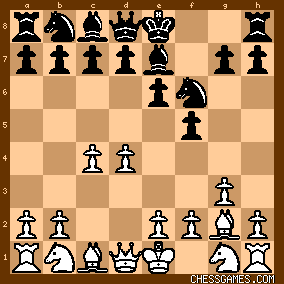
click for larger view5. Nh3?!
5. Nf3 is of course normal. But the text has its points. Keres here made an interesting point:
"A rule of thumb in the Dutch Defense is that this Knight maneuver is good for White only when Black has already chosen the Stonewall set-up by d7-d5." I see Keres' logic, since Nf4 (which the text anticipates) is most useful after the Black d-pawn has gone to d5. As the play goes here, however, Reshevsky got a good position from the opening (and played Nf4 four moves later). Perhaps most significantly, the text may have been a surprise to Botvinnik and an effort to unsettle him in an opening he generally knew so well. 5... 0-0
6. 0-0 d6

click for larger viewAs Golombek and Euwe--following up on Keres' above analysis--point out, Botvinnik refrained here from 6...d5 it light of Reshevsky's fifth move. Despite potentially playing into Reshevsky's scheme, Botvinnik could nonetheless have tried 6...d5. The text interferes with White's plans, but Black has now cramped his game by hemming in his e7 Bishop. 7. Nc3 Qe8

click for larger viewKeres claimd that 7...e5 would have been "premature," but his analysis on this point was questionable. He gives 8. dxe5 as the best response, but that allows Black to equalize easily: 8...dxe5 9. QxQ BxQ. The only way for White to hold any edge after 7...e5 would be with 8. c5, a move not mentioned by Keres. Also premature, as noted by Golombek, was 7...Nbd7 in light of 8. Nf4! Perhaps best of all for Black was the modest 7...c6 with e5 to follow in many variations. In any case, Reshevsky would have emerged from the opening with a good game and undoubtedly the easier position to play. Botvinnik was clearly eyeing ...Qh5 as a way to initiate a King-side attack. This wasn't actually played for another eleven moves, but it now was a possibility with which Reshevsky had to consider as the game developed. The question hanging in the air was not whether and when White would venture Nf4. |
|
Apr-29-23
 | | KEG: Post II
8. e4
Condemned by Keres and by Botvinnik himself. But it sure seems logical. Fritz, after a deep search, played 8. Re1 and rated 8. f4 above the text. Stockfish gives 8. Nf4 as best. But even if any of that were correct, calling 8. e4 is bonkers. On this one, I am with Golombek:
"The text-move is double-edged: it opens up lines for both White and Black on the King side." And Euwe also put it well:
"White seems to get good play; Black will soon be saddled with a weak d-pawn. Against this, however, Black will get a lot of elbow room on the king-side, with the result that he woo will have good attacking chances." Exactly. This is top-level over-the board play. The text leads to all sorts of complexities. But that, among other things, explains why Botvinnik (as well as Reshevsky) was soon in massive time-trouble. By way of contrast, let's examine Keres' suggested 8. Nf4. True, if Black responds 8...e5, White gets the better chances: 9. dxe5 dxe5 10. Nd5. But is this position so much better than the text. Keres also analyzes the consequences after 8. Nf4 Bd8. Now, White just plays 9. e4 and indeed is much better placed. But, to throw some cold water on this reasoning, Black can just play 8...c6 in response to 8. Nf4. Keres suggests 9. Nd3 preventing e5 by Black. But the resulting position is no Shangri-La for White after Black responds with 9...Nbd7. Perhaps realizing that this line is not so wonderful, Keres alternatively suggests 9. e4 which he says "would have been much stronger than in the game. But after 9. e4, Black can solve many of his problems with 9...e5 or 9...fxe4 or 9...Nxe4. In short, both Keres' 8. Nf4 and Reshevsky's 8. e4 are reasonable over-the-board choices. I prefer fighting chess, so I would choose Reshevsky's move. 8... fxe4

click for larger viewGolombek correctly commented that 8...e5 would have been a mistake, but his analysis in reaching this correct conclusion was badly flawed: 8...fxe4 9. dxe5 [White could also play 9. exf5] dxe5 10. exf5 [reasonable, though 10. Nd5 is probably stronger] Bxf5 11. Ng5 ? [Huh?. 11. Qf3 was much better, as was 11. Bxb7. The text forfeits any advantage White had enjoyed] Nc6 12. Nd5? [now Black is actually better. 12. Qb3 was White's best chance here]. In any case, Botvinnik's 8...fxe4 was clearly best. As Horowitz rightly concluded: "...Black accepts a strategic weakness (the backward Pawn at e6) for tactical considerations." Also noteworthy was the time used through just eight moves: Reshevsky: 0:47
Botvinnik: 0:40.
As is obvious, both players had been working hard. And the position was only going to get tougher for both sides from here. 9. Nf4
"!"--(Horowitz)
A new move, as noted by <plang> But wasn't the simple 9. Nxe4 much better. The commentators all disagree, but their criticism of this obvious alternative seem off-base. After 9. Nxe4, Euwe claimed that White would get "an attack on the Knight on h3: 9...NxN 10. BxN e5. But White can address this immediately with 11. Ng5, getting a clearly superior position. Golombek picked up where Euwe left off, but made some mistakes of his own: 11. Ng5 BxN [playing into White's hands...Black should just respond 11...h6] 12. BxB exd4? [this Golombek suggestion should lose after 13. Re1! But Golombek instead has White playing 13. Qxd4? after which Black, though still somewhat worse, would be very much in the game. Keres presented a very different "refutation" of 9. Nxe4: 9...e5?! but he assumes White would not play 10. Nhg5 when both 10. NxN+ and 10. dxe5 would give White a significant edge. After the inferior 9. Nf4, the position was:
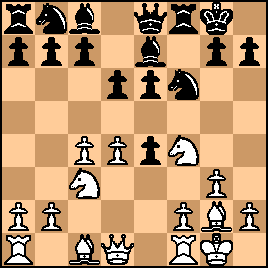
click for larger viewReshevsky was still better, but less so as compared with 9. Nxe4 |
|
Apr-29-23
 | | KEG: Post III
9... c6
9...e5 would be "premature" [Keses]. White would now be better after Keres' 10. dxe5 dxe5 11. Nfd5, <zydeco> suggests 9...Nc6, but White seems much better then after 10. Nxe4 NxN 11. BxN. 9...g5?! looks interesting, but over-the-board it is understandable that Botvinnik would not risk it in so important a game. Keres was right--at least in a practical sense-in opting for the text, which prepares for e5 and keeps White's pieces off d5. 10. Nxe4 NxN
Botvinnik could also have played 10...e5 immediately here. But, especially with the clock situation, the text was most prudent (though 10...e5 would likely have transposed into the actual game). 11. BxN e5
At last!
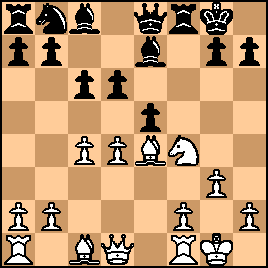
click for larger view12. Ng2
Should Reshevsky have tried for more with 12. dxe5 dxe5 13. Nd3? Keres thought so, and claimed that by playing the text instead, "White loses his last prospects for an advantage." I find the choice between the two moves to be a close one and arguably a matter of style. As Golombek remarked concerning the Keres proposed line: "White gives Black a weak isolated Pawn, but also frees all the lines for Black's pieces." Horowitz found the Keres line appealing, but noted: "...White prefers to keep Black's position cramped." 12... Nd7
Best.
As Golombek correctly stated, 12...Bf5 would allow White to obtain a slight edge after 13. BxB RxB 14. Qb3. Golombek also rightly rejected 12...Bf6, but his analysis had some holes: 13. Qd3 [13. Qc2; 13. d5; and 13. dxe5 were all superior and would have given White a clear advantage; 13...g6 14. dxe5? [giving up most of his edge. White should play 14. d5!] Bxe5? [very weak recommendation by Golombek; 14...dxe5 was far better] 15. f4? [throwing away his powerful chance in 15. Bh6! after which White would have excellent winning chances]. Meanwhile, the clock situation became more critical (with 28 moves yet to play before reaching the move-40 time control): Reshevsky: 1:34
Botvinnik: 1:06
The position was now:

click for larger view13. Ne3
Keres rightly point out that by now Botvinnik had "already overcome the opening difficulties" and that now it was Reshevsky who had to "think about equalizing." 13... exd4
"!"--(Keres)(Euwe)
"A bold decision in view of his weakened d-Pawn but otherwise he cannot complete his development." (Golombek) "Black acts as if there is no such thing as a weak d-pawn, and the course of the game will show that his assessment is correct." (Euwe). As several commentators noted, 13...Nf6 as recommended by Romanovsky would allow White to do more than equalize with 14. Bg2, and then if Black continued 14...e4? White would be clearly better after 15. d5 (Keres' move) or perhaps 15. Bd2 (the computer move). 14. Qxd4
This left:

click for larger view |
|
Apr-29-23
 | | KEG: Post IV
14... Ne5
Paraphrasing Keres, the text was best since it threatens 15...Nf3+ and forces White to play the weakening 15. f4. But this is shortsighted for two reasons. First, White could just play 15. Re1 on his his next turn since after 15...Nf3+ White would be fine with 16. BxN RxB 1. Ng2 (with advantage to White). Better than the text was 14...Bf6. Keres claimed this is bad because White could play 15. Qd3 forcing Black to defend his h7 Pawn. But in fact, Black could just ignore the threat with 15...Ne5 and if then 16. Bxh7+ Black would have excellent winning prospects with 16...Kh8 17. Qb1 (nothing else is better) g6 which would be followed by 18. f4 KxB 19. fxN Qxe5 . 15. f4
Golombek, Euwe, and Keres said this was forced, but White could comfortably play 15. Re1 as discussed above. In fairness to the above commentators, there is nothing much wrong with text. My only point is that it was not forced. 15... Ng4
16. NxN BxN

click for larger viewReshevsky, at best, enjoyed a small advantage here, especially in light of the weak squares around his King. 17. Re1
Reshevsky was itching for battle. Else, as explained by Keres, Reshevsky might have played 17. Qd3 Qh5 19. Bf3, With the text, Reshevsky retained the tension, since, again as per Keres, the text prevents 17...Qh5 because of 18. Bd5+. But, as Keres also points out, the text only provided Reshevsky with a "temporary solution." 17. Bd2, as discussed by Golombek, was not better: 17...Qh5 18. Rfe1 Bd8. 17... Bf6
"!"--(Keres)(Horowitz)
"In the spirit of the position." (Horowitz)
17...Bd8 was arguably better. White might try 18. Bxh7+ (18. Qd3 is simpler) 18...KxB 19. RxQ but now Black draws with 19...RxR!--the two Bishops fully compensating for Black's nominal material inferiority. By contrast, Black would get into trouble here with Golumbek's suggested 19...Bb6 20. QxB axQ 21. RxR (f8) RxR 22. Be3, where White has two extra pawns in the ending and Black's drawing chances are based on Bishops of opposite colors. Whatever the theoretical merits of 17...Bd8, the text was a creative pawn (poisoned pawn) sacrifice by Botvinnik who--like Reshevsky--was obviously playing to win.
I love it!
The text (17...Bf6) left:

click for larger view18. Qd3!
Reshevsky wasn't going to fall for 18. Qxd6? Rd8 and Black is suddenly winning. Similarly, the superficially attractive 18. Bxh7+? loses for White after 18...KxB 19. Qd3 Qg6 18... Qh5
The clocks continued to be factors in the game:
Reshevsky: 1:45
Botvinnik : 1:42
19. Bd2 Rfe8
As all of the commentators point out, 19...Bxb2? placed Black in hot water after 20. Rab1 Bf6 21. Rxb7/ After 19...Rfe8, the position was:

click for larger view |
|
Apr-30-23
 | | KEG: Post V
20. Rab1
"?"--(Golumbek)(Keres)
A surprising mistake by Reshevsky. The flaw in Reshevsky's reasoning was well summed up by Keres: "The pawn on b2 did not require protection here or on the previous move [because of] possibility of 20. Rab1 followed by Rxb7. Hence White should have used the time to neutralize Black's increasing pressure on the e-file." So what should Reshevsky have played here?
Simplest was 20. Bc3 as suggested by Golombek, Horowitz, and Keres. Euwe contended that 20. Bc3 was inadequate, but after 20...BxB (best) 21. QxB and if then 21...Re6 (Euwe's most) White gets a good game with Keres' 22. Re3 Rae8 23. Rae1. In this line, Black could achieve equality with 21...Qc5+ 22. Kg2 Bh3! and then if 23. KxB Black reaches a level Queen and Rook ending with 23...RxB! 24. RxR Qf5+. Probably also sufficient for White is 20. Re3 (Flohr's idea), though after 20...Kh8 21. Rae1 Bxb2 22. Bg2 RxR 23. BxR Re8 24. Qxd6 Qa5 25. Bd2 RxR+ White would have to take great care to hold the game since now only 26. Bf1 saves White (26...Bd4+ 27. QxB Qb6 28. QxQ RxB+ 29. KxR bxB). After 20. Rab1, the position was:

click for larger view20... Re7
"?"--(Golombek)(Keres)(Golombek)
"Black returns the compliment." (Euwe)
As Botvinnik noted after the game, and as all the commentators agreed, correct here and the only way to exploit Reshevsky's last move was 20...Re6. Then it would be White who would have to walk a tightrope to survive. Best now for White would be 21. Re3. Keres thought this was insufficient and recommended 21. b4, but this loses to 21...Rae8 22. Rbc1 and now not Keres' 22...Kh8? which throws away Black's winning chances but 22...Bb2 after which White would be hard-pressed to save the game. After 21. Re3 White would draw easily against Keres' 21...Rae8. Instead, 21...Bd8 would force White to find 22. f5 and then stay on his toes to avoid defeat. By contrast, after 20...Re6! 21. f5, as seems to lose as pointed out by Golombek: e.g., 21...RxB! followed by 22. RxR Bxf5. After Botvinnik's actual 20...Re7, the position was: 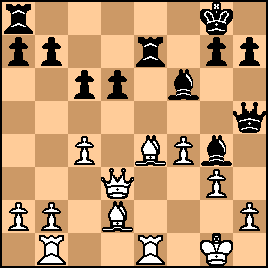
click for larger viewWhite still has to be precise to stay in the game, since 22. Bc3? loses to 22...Rae8 (much stronger than Golombek's 21...BxB? Reshevsky, however, found a strong answer:
21. Bb4
However:
"There is less to this move than meets the naked eye. It has the appearance of a crusher." (Horowitz) The truth in Horowitz' comment will soon become apparent. But Reshevsky's move was good enough to yield approximate equality (whatever that means in so complicated a position). Also sufficient for White here was Keres' 21. Re3 Rae8 (21...RxB 22. RxR Bf5 23. Rbe1 BxR 24. RxB Bxb2 25. Re3 Bf6 26. Re6 d5 27. cxd5 Qxd5 28. QxQ cxQ 29. Rd6) 22. Rbe1 [forced] with equality [for if 22...Bxb2? 23. Bxh7+ wins for White). After 21. Bb4, the position was:
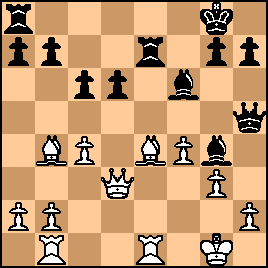
click for larger viewFrom here, the real drama of this game was about to unfold with both players in increasingly severe time trouble. |
|
Apr-30-23
 | | KEG: Post VI
21... Rae8
"!"--(Horowitz)
"An excellent rejoinder...but not for the reason Botvinnik has in mind!" (Horowitz) "Black cannot afford to waste time defending the d-pawn." (Euwe) "This pawn sacrifice is practically forced." (Keres) I also fancy Botvinnik's move, but it was far from "forced." But 21...Rd8 (or 21...Rd7)--the computer move--was at least theoretically good, though almost certainly not the best choice over-the-board. Thus, if Black plays the much-maligned 21...Rd8, he should be fine, though the complications in games between humans make it hazardous. If 21...Rd8 22. Bxd6 (Keres' move), Black would be fine after 22...RxB! [a move Keres apparently overlooked, Black would even have a small edge (e.g., 23. QxR Rd7 24. Qa3 Rd2 [here comes the counter-attack] 25. Bg2 (practically forced) Bf5 26. Qf3 [another practically forced move] Bd4+ 27. Kh1 Bh3! 28. Re8+ [only this counter-sacrifice or the daring 28. g4 would have any hope of saving the game for White] QxR 29. BxB Bxb2 30. Rd1 RxR+ 31. QxR Qe4+ when White likely draws with ease because of the Bishops of opposite colors). While defending the d-pawn with 21...Rd8 was thus OK, the text was undoubtedly the better practical choice (i.e., for humans). On the other hand, defending the d-pawn by 21...c5 would be bad, as pointed out by Golombek: 22. Bd5+ Kh8 23. RxR BxR and now, while Golombek's 24. Re1 would be very strong, the real killer is 24. Bc3 after which Black would be hard pressed to survive the two sweeping White Bishops. After Botvinnik's 21...Rae8, the position was:

click for larger viewIn this very difficult position with nineteen (19) moves yet to play to reach the move-40 time control, the clocks revealed a scary time situation for both players: Reshevsky: 1:58
Botvinnik: 1:57
22. Bxd6
Forced, If instead 22. Bg2, White gets crushed by 22...a5!, which is even stronger than Golombelk's 22...Bf5 (which likely also is sufficient to win). Also losing for White, as noted by Golombek, was 22. Qxd6 Re6 (or--even better--22...Rd7). Reshevsky's famed prowess in time-trouble helped him avoid these pitfalls at this junction of the game. 22... Re6!
Believe it or not, anything else probably loses for Black. Horowitz speculated (based on what I have no idea) that Botvinnik had originally planned to play 22...RxB? Whether that is true, both Horowitz and Golombek demonstrated that 22...RxB? would have been a mistake: 23. RxR RxR 24. QxR Bf5 [the superficially crushing skewer] because White can play 25. Qe3! Bd4 [25...BxR?? runs into mate in 3 after 26. Qe6+] 26. QxB BxR 27. Bb4 after which Black would have to struggle hard to hold the pawn down Queen and opposite colors ending. After 22...Re6!, the position was:

click for larger viewMeanwhile, the clock continued to tick down:
Reshevsky: 2:02
Botvinnik: 2:04
23. Re3!
Reshevsky yet again found the only move to avoid trouble (though 23. Be5 might also allow White to survive). "The pin of White's King Bishop leaves White with little recourse." (Horowitz) 23. Rd8? would have lost to 23...Rd8 (as per Golombek and Horowitz). And 23. c5? would have failed against the quiet 23...Kh8 [I love these quiet killer. Here, Golombek's suggested 23...Bf5 would allow White to escape with 24. Be5. After 23. Re3, the position was:
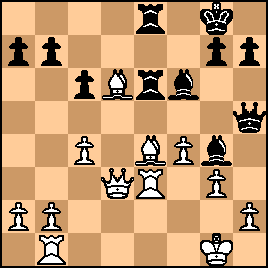
click for larger viewIn this position, Botvinnik (who, like Reshevsky was a beast when in time trouble) unleashed a brilliancy that was unanimously--and grossly unfairly as I will discuss in my next post on this game--criticized by all of the contemporary critics. So far as I am aware, the strength of Botvinnik's next move was first recognized on this site by <zydeco>. In addition, the trashing of Botvinnik's upcoming move was noted here almost ten years ago by <SimonWebbTiger>. |
|
Apr-30-23
 | | KEG: Post VII
23... RxB!
"?"--(Golombek)(Horowitz)(Euwe)
Keres did not expressly assign a "?" to this move, but he joined condemnatory throng: "For once the normally impeccable Botvinnik has overlooked the right move." (Golombek) "Proving that he does not realize his own strength" (Horowitz) "A reckless sacrifice that turns the tide" (Euwe) "...the exchange sacrifice is tempting, but it brings difficulties only to Black" (Keres) Only here has Botvinnik's fine effort (all the more remarkable given his horrific time pressure) received the acclaim it warrants: "!"--<zydeco)
Even more remarkable is that Botvinnik's clock left him virtually no time to analyze the fearsome complexities of the position: Reshevsky: 2:07
Botvinnik: 2:20
While the text was excellent, there were other good options for Black, including 23...Bf5. While correctly seen as a good option, the commentators did not always correctly analyze 23...Bf5 (Keres going so far as to overstate the case ["23...Bf5 had to be played"--missing not only the text but also 23...Kh8 and 23...h6]: The position after the much lauded 23...Bf5 would have been: 
click for larger view24. Be5 would then be essential for White. If instead 24. Rbe1 (recommended by Flohr and Romanovsky and said by Horowitz to be "good enough for a draw") would have lost to 24...BxB [and to the even better 24...RxB!--sacrificing a second exchange, i.e., 25. RxR RxR 26. RxR BxR 27. QxB Qd1 28. Kg2 Qd2+ 29. Kf3 QxB]. After 24. Be5 Black equalizes with 24...BxB(e5) [better than 24...BxB(e4) 25. RxB BxB 26. RxB (or the super-complicated 26. fxB or even 26. Rbe1) RxR 27. fxR Qxe5 28. Rf1 with an absolutely even Queen and Rook ending. Anyway, let's return to the actual game after Botvinnik's 23...RxB. 24. QxR
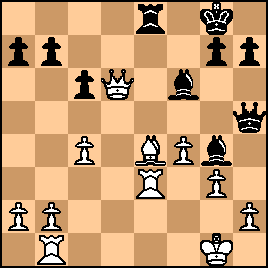
click for larger view24... Rd8
Forced. As Keres noted, the superficially appealing 24...Be7 would have lost to 25. Bd5+! [25...Kf8 26. RxB RxR 27. Re1 Qe8 28. Be6 (or 28. Bg8) BxB 29. RxB b6 (I see nothing better) 30. Kf2 (or 30. b4 or 30. RxR) Qf7 31. QxR+ QxQ 32. RxQ KxR 33. Kf3 with an easily won King and Pawn ending] 25. Qc7
"The text thwarts 25...Rd2 because of 26. Bd5+." (Keres) As Keres and others pointed out, 25. Qb4 would get crushed by 25...Bd4. However, 25. Qa3 was also good despite Keres' claim that it would allow a "strong attack" by Black after 25...Rd2. Rather, with 26. h4 Bd4 27. Rbe1 the game is even, e.g., 27...Be5 28. Kh1 (forced) BxR 29. QxB BxB+ (forced) 30. QxB h6 (pretty much forced) 31. Qe6+ Kh7 32. Qe4+ Qg6 33. f5 Qxg3 34. f6+ (forced) Qg6 35. QxQ+ KxQ 36. fxg7 (forced) Kxg7 37. Re7+ Kg6 38. Rxb7 Kh5 39. a3 Kxh4 40. b4, etc. After 25. Qc7, the position was:

click for larger viewMeanwhile, both players were nearly out of time. And let's not forget, Botvinnik in this wild position was down a pawn plus the exchange. |
|
May-01-23
 | | KEG: Post VIII
The accuracy and creativity of Reshevsky and Botvinnik to this point in the complex middle-game was almost super-human. But as time grew increasingly short, even these fine players began to err: 25... Qc5?
"?"--(Keres)
"With this brutal winning attempt...Black seriously jeopardizes his position." (Keres) Quite true. After this slip, Black was almost certainly theoretically wrong. Keres' suggested 25...Rd7 is sufficient to hold (as were 25...Rc8 and 25...Re8). But the game was so difficult at this stage that even the analysis of Keres had serious holes: 25...Rd7 26. Qc8+ Rd8 27. Qxb7? [This Keres recommendation should lose. 27. Qc7 was essential] Bd4 28. Rbe1? [This only makes matters worse for White. The best chance lay in 28. Qb3]. After 28. Rbe1?, Black does more than draw as Keres said, but has a forced mate after 28...BxR+ [e.g. 29. RxB Rd1+ etc.]. After 25...Qc5, the position was:
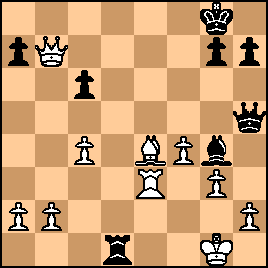
click for larger viewOut of nowhere, Reshevsky now had a win in hand. But the position was still riddled with pitfalls. 26. Rbe1
Forced.
26... Rc8
The best try, though inadequate against best play. 26...Rd7? (as previously discussed on this site) gets crushed by 27. Qc8+ (27...Kf7 28. Bc5+ etc.] And 26...Rd1? loses to 27. Bd5+. Euwe reported that Botvinnik played 26...Rf8? here, but Reshevsky would surely have crushed that with 27. Bd5+. 27. Qxb7
So many ways for both sides to lose here!
27... Bd4
This pin was obviously Botvinnik's only chance. It left: 
click for larger view28. Kf2?
"?"--(Golombek)(Horowitz)(Euwe)(Keres)
"It is White's turn to err." (Golombek)
"Both players were already [long since--KEG] in time trouble and therefore play the last part of the game inexactly." (Keres) As every commentator has pointed out, White's only way to win was with 28. Qb3! This wins in every variation: (a) 28...BxR+ 29. QxB [or 29. RxB] Qxc4 30. Qxa7 leaving White three pawns to the good. (b) 28...Qa5 29. Kf1 Qd2 (or 29...BxR 30. RxB) 30. R3e2 BxR+ 31. RxB Qc1+ 32. Kg2 Qg1+ 33. Kh3 etc. (c) 28...Re8 29. Kg2 BxR 30. QxB QxQ [there is nothing better] 31. RxQ leaving White two pawns up in an easily won endgame. After the text, Botvinnik was back in the game:
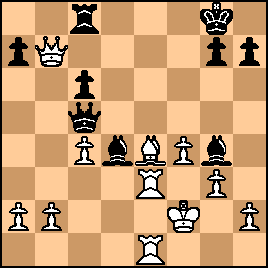
click for larger view |
|
May-01-23
 | | KEG: Post IX
28... BxR+
This move may seem too obvious for words, let alone detailed analysis. And alternatives such as 28...Rd8 were plainly unsatisfactory (e.g., 29. Qb3 BxR+ [Golombek's 30...Qa5? would be even worse: 31. Bf3!] 30. QxB Rd2+ (what else?] 31. Kf1 QxQ 32. RxQ Rxb2 33. Bxc6 Rxa2 34. Bd5+ Kf8 35. Rb3. But after the game, it was initially believed (according to Keres) that Black could actually have won with 28...Qa5. Indeed, White has only one saving move in this variation--29. Bf3!--but that move, far from leading to victory for Black, actually leads to a small edge for White: 29...Re8 [forced. If instead 29...Qd2+ (the move at first considered best) actually loses after 30. R1e2 (forced) BxR+ 31. Kg2!! (another incredible quiet crusher in this game) BxB+ 32. KxB and suddenly Black is dead. Yet again, Botvinnik--with nearly all his time gone--found a correct move that was initially missed by commentators who were not operating under any time constraints. 29. RxB
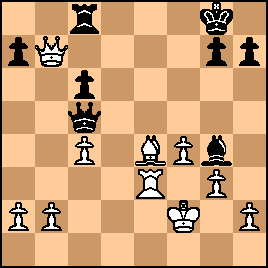
click for larger view29... Qd4?
"?"--(Keres)
As Golombek, Keres, and <plang> here have all correctly stated, Botvinnik could have drawn here with 29...Rd8 30. Qb3 (forced) Rd2+ (forced) 31. Kg1 Rd1+ and draws by perpetual check. But Botvinnik--according to Keres--was still seeking a win and now got into what should have been serious trouble, the position now being: 
click for larger viewIt must, needless to say, be mentioned that the players were now in desperate time trouble: Reshevsky: 2:20
Botvinnik: 2:24
30. Qb3?
Here, as nearly everybody has pointed out, Reshevsky would have had decent winning chances with 30. Bf3! Re8 (everything else loses immediately, e.g., 30...Qd2+ 31. Re2 [even better than Golombek's 31. Be2] and Black is dead) 31. Qb3 RxR (not 31...BxB? 32. KxB RxR+ 33. QxR leaving Black in a losing Queen endgame) 32. QxR Qxb2+ 33. Qe2 Qd4+ 34. Kg2 BxB+ 35. KxB Kf7 and Black will have to struggle long and hard to have any chance to survive the pawn down Queen and Pawn ending. After Reshevsky's inaccurate 30. Qb3, Botvinnik seized the chance to force a draw by perpetual check: 30... Qd2+

click for larger view31. Kf1
Obviously forced. White gets quickly mated if he plays any other move. 31... Qc1+
31...Be2 would put Botvinnik back in jeopardy after 32. h4 (32. RxB? QxR 33. Bxc6 RxB 34. Qb8+ Kf7 35. Qb7+ Qe7 36. QxR Qe1+ 37. Kg2 Qe2+ draws). But Botvinnik was clearly no longer going to play with fire with little time left on his clock and clinched the draw. 32. Kf2 Qd2+
33. Kg1 Qc1+
Drawn
What a fight! |
|
May-01-23
 | | nizmo11: thank you <keg> as always an excellent analysis!
two comments:
On move 12 my Stockfish likes 12.Qd3!?
(12...exf4 13.Bxh7+ Kh8 14.Bg6! Qd8 15.Bxf4) and claims some advantage for White. if true, this changes the evaluation of the previous moves.
Then to move 25..., or rather about Keres's comments.
I have the modern translation <"2nd edition 2017, copyright Paul Keres, 1949, Jan Verendel 2016."> in this version on page 226: "It was essential to force draw by the continuation 25...Rd7 26.Qc8+ Rd8, because the capture 27.Qxb7 loses [and the variation given here]. Did Keres perhaps originally wrote something different? |
|
May-04-23
 | | KEG: <nizmo11> Thank you for your important additions to my posts and for your kind comments. I had not given much thought to 12. Qd3 since the sacrifice of the Knight for two pawns looked insufficient. I now see that Stockfish recommends the move and that White's attack is stronger than I had previously recognized. This is obviously an important alternative that deserves much consideration. Having now examined the move more carefully, I am convinced that it gives White a meaningful advantage. After your line (12. Qd3 exN 13. Bxh7+ Kh8 14. Bg6 [the only possible way for White to justify the sacrifice] Qd8 15. Bxf4, it at first sight appears that White at best has equalizing compensation for giving up the piece for two Pawns. But the likely continuation seems to point strongly towards your move: 15...Kg8 [seems clearly best] 16. Rae1 [better than playing for a draw with 16. Bh7+ Kh8 (not 16...Kf7?? 17. Qg6 mate!] Nd7 18. Re2 White is clearly better with more than adequate compensation for the lost material. A great find. Thank you.
As for what this means about the merits of the previous moves, the only culprit I can find in Black's play is 7...Qe8, a move I had already questioned. I revert to my prior suggestion of 7...c6 or, alternatively, 7...e5. In addition, your discovery suggests that my rejection of Reshevsky's 9. f4 (to which Horowitz assigned a "!") in favor of 9. Nxe4 was superficial. Once again, great find!
With regard to Keres' comment about the merits of 25...Rd7 (rather than Botvinnik's 25...Qc5), you are correct that I have done Keres a serious injustice. In my effort to show that after 25...Rd7 26. Qc8+ Rd8 27. Qxb7? Bd4 Keres' 28. Rbe1? was awful (28. Qb3 being the only chance), I completely failed to point out that Keres had indeed--as you say--pointed out that 27. Qxb7? loses. Thus, it was, as you correctly point out, quite wrong for me to call 27. Qxb7 a Keres "recommendation." My only excuse for this mistake was the difficulty of trying to analyze this extremely complicated game from start to finish. Still, this was no real excuse for misquoting the great Paul Keres. Thank you for your two very important corrections. It is because of such corrections that I find it so valuable to post my thoughts about the games I am playing over on this site. Good job! |
|
 |
|
< Earlier Kibitzing · PAGE 2 OF 2 ·
Later Kibitzing> |
|
|
|





